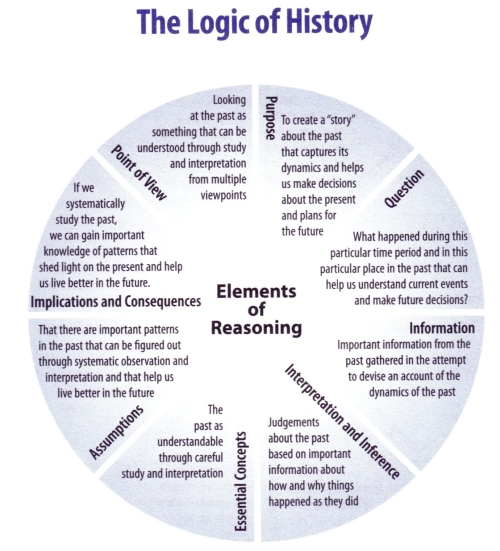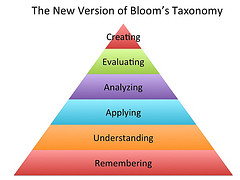
Our Approach to History
aka Your Guide to Thinking like a Historian
Updated 4/11/18:In course design, I follow advice attributed to Albert Einstein (physicist, 1879-1955): "I never teach my pupils. I only attempt to provide the conditions in which they can learn." You learn history by DOING! You think like a historian and do what historians do. That's how to really learn history! To elaborate, I design courses around the most recent findings of neuroscience to maximize effective student learning. "The primary message from neuroscience researchers is relatively simple: 'The one who does the work does the learning.' Only when you practice, read, write, think, talk, collaborate, and reflect does your brain make permanent connections. Your teachers cannot do this for you, and at times this work will make you tired. When you are worn out from learning, rest a bit and reflect on the fact that you are changing the neurochemistry of your brain. That is pretty amazing." [Terry Doyle & Todd Zakarjsek, The New Science of Learning, Stylus Publishing, 2013, p. 12.] We Study History Using Inquiry-Guided Learning (IGL)
As noted, you learn history by doing what professional historians do. You analyze and evaluate a variety of primary sources (critical thinking), interpret their meanings, and construct an explanation [interpretation] of the past based on this empirical evidence (creative thinking). The raw material for our inquiries is a variety of historical documents and images--firsthand accounts, paintings, photographs generated by those who made history. While we're using historical materials, the cognitive skills you develop are applicable to any type of data and any field of study or career path. You will find relevant primary sources, along with interpretive commentary for context, in my online learning environment Latin America: An Interactive History Lab, used in HI 216-601, my online course.Constructivism: You create [construct] your own interpretations of the past, instead of merely memorizing facts or passively accepting and repeating prepackaged views formulated by others. The "guided" part of the inquiry is embedded in the history learning laboratory I created. The guidance includes these elements:
[1] selected primary sources you analyze. [In the real world of historical work, you would research and uncover your own sources.]
[2] Guidance through the use of leading questions, debates, and role-playing assignments.After creating your interpretation, you can check it against the scholarly views provided in the history lab chapters and in email mini-lectures from Prof. Slatta. sources. As you gain experience, your conclusions will more closely match those of experts in the field. You will also move from apprentice historian to more autonomous, self-reflective scholar as the semester progresses. An inquiry approach requires you to integrate (combine) different sources of information into a logical whole rather than passively memorizing the analysis of others. To assist you in source integration, you may wish to use this Synthesis Matrix. We Pursue a Variety of inquiries in IGL
- Political inquiries ask how did public policies & laws come to be. Which social groups have the greatest power in constructing political boundaries? Under the established rules who wins? Who loses?
- Economic inquiries ask how are goods and services produced, distributed, and consumed. How are resources, such as land, employment, property, income, allocated?
- Social inquiries come in a wide range of forms. They focus on social institutions and social characteristics, such as the family, communities, education, health, and quality of life. They probe differences in society based on gender, ethnicity, and social class.
- Cultural inquiries examine the artistic and cultural production of a society and interpret what that production tells us about the nation's or social group's values and concerns. Materials might include art work, dance, literature, music, or architecture. In some assignments, you will explore myths, archetypes, and historical memory.
- Some inquiries combine elements from several categories of the above list. Use the course examples to practice developing your own high-level questions.

Our IGL approach facilitates higher levels of critical thinking, as measured through the useful Bloom's Taxonomy of Cognitive Levels. That is, we emphasize analyzing evidence [breaking big issues into constituent parts], critically evaluating historical sources [learning how to judge which are more trustworthy], and creating our own interpretation of the past (Bloom's 3 highest cognitive levels). Our goal is for you to function as an intellectual inquirer" rather than a "partisan ideologue." Put another way, we want you to evaluate and analyze evidence, not respond to new information with simplistic, knee-jerk opinion. Creative thinking enters into your creation of historical interpretations to explain past events. We Write to Learn and Learn to Write
You do lots of writing in Slatta's history classes. Informal writing (short inquiries) provides practice in writing to learn. Emphasis lies in sharpening thinking, not in writing mechanics. Formal writing assignments combine writing to learn with learning to write. Your thinking remains primary, but we also examine writing mechanics [word use, organization, tenses, punctuation, grammar]. I hope that by considering "why" I ask you to do these tasks, you'll appreciate their importance and gain competency at doing them. For more on the assumptions behind this approach, read my teaching philosophy. So jump in with both feet--and enjoy. It's not every day you get to make history!